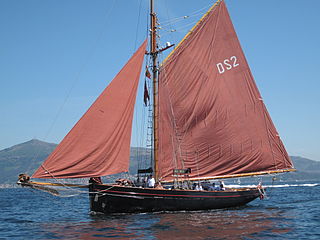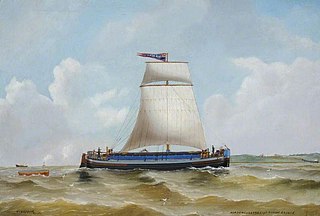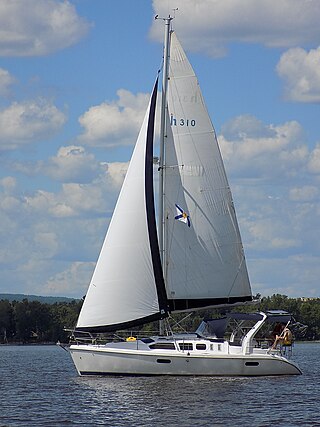Mark 1 Corribee
Mk 1, Clinker
The first Corribee was designed by Robert Tucker in 1964. Around 10 wooden Corribees were clinker built before production moved to the fibreglass Mk 1. The early Corribees have a centreboard which gives them a minimum draft of 1 ft 11 in (0.58 m), shallow even compared to the bilge-keeled later models which are themselves favoured for their shallow draft. With the centreboard lowered, the Mk 1 clinker Corribee draws 3 ft 3 in (1.0 m). Raised and lowered by means of a winch in the cockpit, the centreboard is housed in a small fin which protrudes from the hull of the boat, as such it does not intrude on the cabin floor. [2]
Corribee number 1
In 1963 a Dragon-class enthusiast wanted a smaller boat with the feel of a Dragon, but with "a cruising ability all her own" and commissioned a design from Robert Tucker. [3]
Robert Tucker’s 1963 drawings bear the working name of "Sea Nymph"; the inspiration for her name came from fishing on the banks of Loch Corrib in Galway, Ireland. [4] [5]
Corribee was clinker-built in mahogany on oak at Tommy Mallon's yard by Loch Corrib in 1964 / 65. Corribee, sail number 1, eventually lent her name to the entire class of "Corribees". [6]
Some 10 or so wooden clinker "Corribees" were built at Tommy Mallon's Yard before construction moved to Heron Marine at Herne Bay, who built a lighter plywood-planked version. Newbridge Boats in Dorset started to produce a GRP version called the "Corribee 21", later to be known as the "Mark I" Corribee, followed by several variants of the Mark II, then the Mark III. [7]
In winter 1965 Corribee left Éire to be launched on the Medway - an undated surviving photograph (possibly from this time) shows her with a blue hull and white topsides. [8] [9]
Corribee’s 21st Birthday was celebrated at Gravesend Sailing Club, presumably in 1986, photographs show her transom bearing the name "Corribee 1" and "GSC" (presumably "Gravesend Sailing Club") and she is then sporting an emerald green hull with cream topsides. [10]
At some time in the 1990s, Corribee hit an underwater obstruction sailing on the Thames and sank. She was raised and put into storage in a shed on the Isle of Dogs. [11] [12]
She was due to be repaired, but had to be rescued from over-zealous restoration (including stripping all her paint, and stripping out of some of her decks and interior…) and she was moved to another storage shed. [13]
Having found a new owner determined to save this classic boat, and the night before Corribee was due in Clare Lallow's Yard at Cowes for a complete restoration, the new owner found vandals had forced the door on the shed and lit two fires under her hull. [14]
In spite of this, Laurie Borer and the team at Lallow's, and with help from the original drawings, restored her to her former glory. [15] [16] Corribee was relaunched by Jean Cook of the Corribee Owners' Association on Saturday 9 May 1998 from Lallow's Yard on the Medina, and was put up for sale in 2010. [17] [18]
Her new owner took her to the Lakes, but she was sold again in 2012. Her current owner asked Laurie Boarer at Lallow's to restore her to pristine condition again, and she has been stored undercover ever since. [19] As she approaches her 50th birthday, this classic yacht is again for sale.
Mk 1, Fibreglass
In the early 1970s, production of the Corribee moved to Newbridge Boats Ltd who built it in fibreglass. Known as the Newbridge "Corribee 21" in the brochure, she was sold as "a fin keel version of the original centreboard clinker boat". The Mk1 was also built as a twin keel boat which has a shallower draft than the fin keel version and has the advantage of staying upright if run aground or kept on a drying mooring. [20] Compared to the later Mk 2 and Mk 3 Corribees, the Mk 1 has a few distinguishing features. The Mk 1 has a circular cover on the lazarette, the coachroof is wider than on later models and consequently has narrower side decks and more room below. [21]
Significant voyages
There have been a number of significant voyages completed in Corribees, including a number of circumnavigations of Great Britain and transatlantic crossings.
In 1978 Sgt. Alan Toone made a double transatlantic crossing in his Mk 2 Corribee, Corrie Bee completing the 8,467 mile round trip in 97 days. [22] In 1983 Mike Spring, a paraplegic sailor, sailed single handed to Ponta Delgada, Azores in his Coromandel 3M Mariner. [23] In 1995 Ellen MacArthur circumnavigated Great Britain via the Caledonian Canal in her Corribee, Iduna.
More recently Katie Miller emulated Ellen MacArthur's voyage in her Corribee, Elektra; she made the circumnavigation to raise finds for the Ellen MacArthur Trust. In recognition of this voyage she was awarded the 2006 Raymarine Young Sailor of the Year award. [24]
As part of the 2008 Jester Azores Challenge Roger Taylor sailed from Plymouth to Praia da Vitória, Azores in his junk-rigged Corribee, Mingming, finishing in just under 21 days. [25]
In the summer of 2008, Jack Daly completed his single handed circumnavigation of Great Britain via the Caledonian Canal in Padiwak; the voyage took him 12 weeks. [26]
Voyage attempts
In 2006 Roger Taylor retired from the Plymouth to Newport Jester Challenge. He sailed his junk-rigged Corribee, Mingming to a point North East of the Azores, a total of 2,500 miles non-stop from Plymouth back to Burnham-on-Crouch, retiring only due to a slower than expected boat speed meaning he'd be at sea well into hurricane season, something Taylor described as "a risk too far". [27]
In 2008 while Jack Daly was on his circumnavigation via the Caledonian Canal, Jonny Moore retired from a complete circumnavigation of Great Britain via the Pentland Firth in his Mk 2 Corribee Casulen II. His effort was still successful in raising money for the Kendal Sea Cadet Corps.

The Norfolk wherry is a type of sailing boat used on The Broads in Norfolk and Suffolk, England. Three main types were developed over its life, all featuring the distinctive gaff rig with a single, high-peaked sail and the mast stepped well forward.

A daggerboard is a retractable centreboard used by various sailing craft. While other types of centreboard may pivot to retract, a daggerboard slides in a casing. The shape of the daggerboard converts the forward motion into a windward lift, countering the leeward push of the sail. The theoretical centre of lateral resistance is on the trailing edge of the daggerboard.

Colin Archer was a Norwegian naval architect and shipbuilder known for his seaworthy pilot and rescue boats and the larger sailing and polar ships. His most famous ship is the Fram, used on both in Fridtjof Nansen's and Roald Amundsen's polar expeditions.

Jolie Brise is a gaff-rigged pilot cutter built and launched by the Albert Paumelle Yard in Le Havre in 1913 to a design by Alexandre Pâris. After a short career as a pilot boat, owing to steam replacing sail, she became a fishing boat, a racing yacht and a sail training vessel.

A leeboard is a form of pivoting keel used by a sailboat largely and very often in lieu of a fixed keel. Typically mounted in pairs on each side of a hull, leeboards function much like a centreboard, allowing shallow-draft craft to ply waters fixed keel boats cannot. Only the leeward side leeboard is used at any time, as it submerges when the boat heels under the force of the wind.

The junk rig, also known as the Chinese lugsail, Chinese balanced lug sail, or sampan rig, is a type of sail rig in which rigid members, called battens, span the full width of the sail and extend the sail forward of the mast.

The Hunter 23 is an American trailerable sailboat, that was designed by Hunter Marine and first built in 1985.

The word Drascombe is a trademark that was first registered by John Watkinson who applied it to a series of sailing boats which he designed and built in the period 1965–79 and sold in the United Kingdom (UK). They comprised the Coaster, Cruiser Longboat, Dabber, Drifter, Driver, Gig, Launch, Longboat, Lugger, Peterboat, Scaffie, Scaith and Skiff, together with a few other one-offs. They have wide and deep cockpits, adaptable boomless rigs and high bulwarks.
The Newbridge Navigator is a sailboat that became popular due to its performance, spacious interior, and affordability.

The Phantom is a British sailing dinghy that was designed by Paul Wright and Brian Taylor as a one-design racer and first built in 1971.
The Falmouth Quay Punt was a type of working sailing vessel in the port of Falmouth, Cornwall in the 19th and early 20th century. They would be hired by merchant ships anchored in Carrick Roads – to carry stores, mail and passengers. Falmouth, with a good deep water harbour situated near the Western entrance to the English Channel, was a popular port for merchant sailing ships to call "for orders". Before the days of radio, captains would often not know which port their cargo would be destined for before they arrived in the country, and needed to collect instructions before continuing.

The Humber keel was a type of single-masted, square-rigged sailing craft used for inshore and inland cargo transport around Hull and the Humber Estuary, in the United Kingdom, particularly through the late 19th and early 20th centuries.
The following outline is provided as an overview of and topical guide to sailing:

The lug sail, or lugsail, is a fore-and-aft, four-cornered sail that is suspended from a spar, called a yard. When raised, the sail area overlaps the mast. For "standing lug" rigs, the sail may remain on the same side of the mast on both the port and starboard tacks. For "dipping lug" rigs, the sail is lowered partially or totally to be brought around to the leeward side of the mast in order to optimize the efficiency of the sail on both tacks.
The C&C 37 is a Canadian sailboat, that was designed by Robert W. Ball of C&C Design and first built in 1981.
The C&C 40 is a series of Canadian sailboats, that were all designed by C&C Design and first built in 1968.

The Hunter 310 is an American sailboat, that was designed by the Hunter Design Team and first built in 1997.

The Frigate 36 is a Canadian sailboat, that was designed by C&C Design and first built in 1968. It is named in honour of the Frigate warship class.
The C&C 44 and the C&C 44 Custom are a series of Canadian sailboats, that were designed by Robert W. Ball and first built in 1985.
The Sovereign 20 is an American trailerable sailboat that was designed by the Sovereign Design Group as an daysailer and cruiser and first built in 1982.












